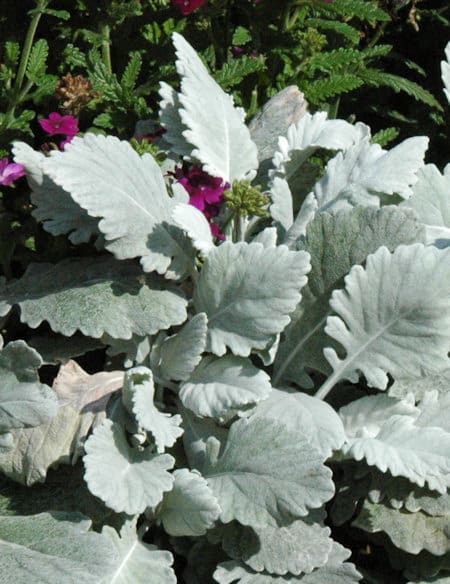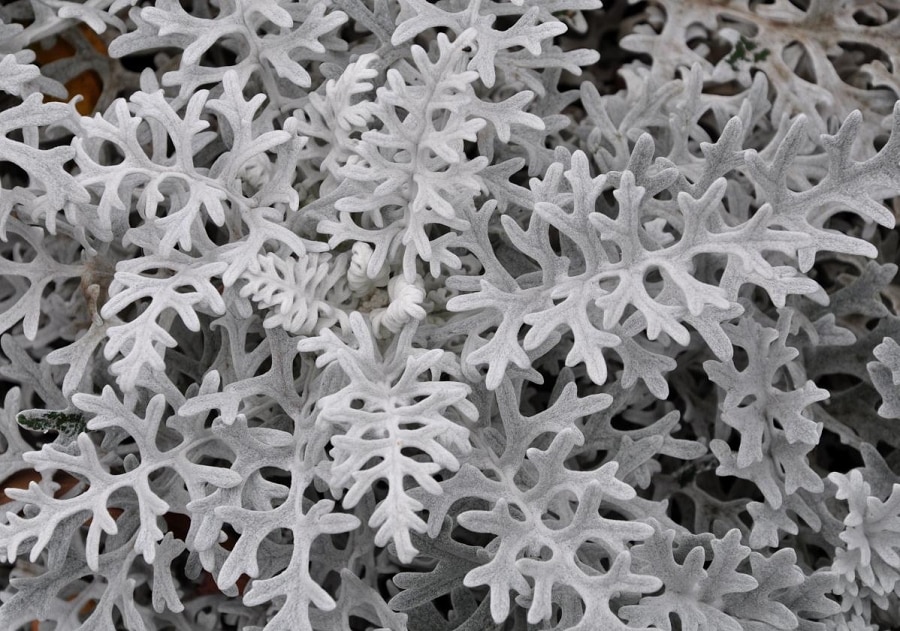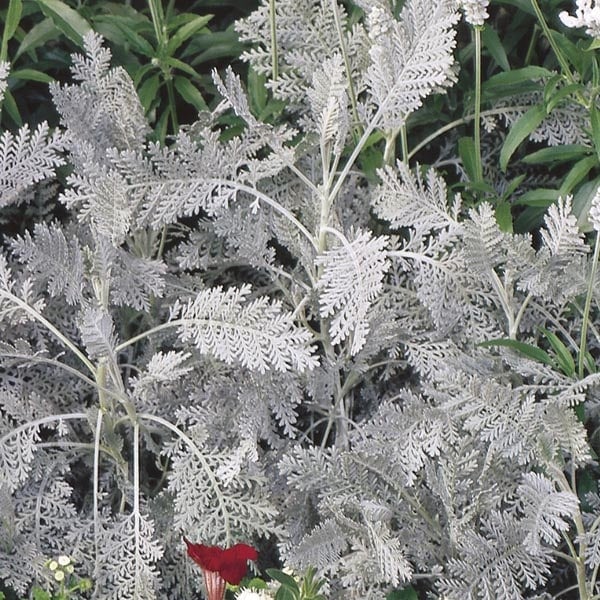What’s the first thing thought that comes to your mind when you heard the name Dusty Miller? In all probability, you imagine dark alleyways, silent nights, resolute detectives, and spooky villains from a crime novel. No matter where your train of thoughts leads you, it’s bound to be a place that’s fascinating.
But you know what’s even more fascinating? Dusty Miller is actually a plant that is perfect for decoration. Yeah, fancy name, right? What makes the Jacobaea Maritima (Dusty Miller) such an attractive plant are their gorgeous silver felted leaves and voluptuous built.
Plus, you don’t have to go around in circles caring for them as they’re pretty low maintenance. Not only can this plant give your flower garden a completely different look, but ultimately alter its aesthetic appeal. Still not convinced? Well, read on further, and we are sure we can change your mind.
About Dusty Miller
The Dusty Miller is a fascinating plant, favored for its silvery grey foliage and lacy leaves that are a treat to look at. Although the flower blooms around Midsummer, it isn’t until they have entirely grown that they are considered to be showy.
The small yellow blooms aren’t quite the looker, but thanks to the plant’s drought resistant capability, the flowers grow to full bloom quite easily. One of the main reasons people like this plant is because they stay alive throughout the summer heat and retain the garden’s fresh look.
Hey, it also tolerates frost! So, we can say that its resilience is more than your level when it comes to tolerating the mother-in-law (Joke!). Naturally, these plants occur mostly along rocky cliffs and coasts in different parts of the world. These woolly plants are in southern Europe, North West Africa, and far West Asia most of all.
The plant is adaptable to many soil types, ranging from sandy loam to acidic clay. Just be sure to drain the soil well to prevent the root from rotting. If you’re going to grow this plant at home, we advise you to water it immediately after planting and withhold watering until the time the root has developed, and the plant starts to grow.
Types of Dusty Miller
-
Cirrus
Cirrus Dusty Miller is a good choice for those looking for an alternative to traditional Silverdust. This plant has large and round silver leaves and is known for outstanding weather resistance properties. The Cirrus color lends a beautiful accent to other bedding plants with their white woolly leaves that provide an excellent contrast.

via pinterest
-
Silver Dust
Silver Dusts, as the name implies, are a more silvery variant of Dusty Miller than the Cirrus. The leaves of this plant are cut in a rounded off way that may or may not resonate with everyone. Its fronds’ shape is reminiscent of large snowflakes, and most of all, the plant is extremely low maintenance and tolerant of drought.

via: www.harrisseeds.com
-
Silver lace
Silver lace is among the more delicate-looking plants in this group as the structure of the plant itself is compact and fine. Silver lace is as attractive as any other variant, if you are aware of the size it will grow to. This plant is also weather resistant and can withstand drought without any hiccups, making it an excellent summer addition.

How to Care for Dusty Miller
Most of the Dusty Miller varieties are undemanding plants that grow best in places that receive ample sunlight. But, these plants can retain their color good enough when they are in full or partial shade as well. The fact that these plants require, so little care is a miracle in itself! However, we don’t mean to say that they do not need taking care of at all.
Here are some caring tips you should follow in various stages of the plant’s life:
In the planting stage
Time for planting seed
You can efficiently start planting the Dusty Miller seeds indoors approximately 10 weeks to the time frost passes. Since these seeds are tiny and their germination requires ample light, they should be sown only on moist soil and left wholly uncovered.
You should place the container anywhere that has a temperature of 70° on an average and where they receive a lot of light. In about 10 or 15 days, you should see the seeds germinate. Planting the seeds of Dusty Miller is one of the most straightforward processes ever.
Transplantation method
For the ideal transplantation, dig a hole of the same size as your plant’s container and take a small amount of dry soil to cover the root balls. At this period, protecting the root is of the essence, which is why you should compact the soil with either more water or more soil, as needed. Messing up this part can lead to less than favorable results.
Water required
Since the Dusty Miller is a resilient plant, you can water it once a week if the temperature is mild. If you’ve planted in temperatures exceeding 90°, then you have to water the plant twice a week. Regardless, that’s hardly anything that we can call maintenance intensive.
Light
We’ve said it before, and we’ll say it again – Dusty Miller plants do just fine in low or partial light. However, it doesn’t hurt to let them bask in the sun’s glory once in awhile. Keep them under sunlight long enough, and the plants will reward you with even more lively colors and optimum growth.
If the place where you live is predominantly warm, then it wouldn’t hurt to keep the plant under the shade from time to time.
Ideal soil
The ideal condition for compact growth comprises of well-drained soil that wouldn’t let root rot set in. You’d want to avoid root rot as much as possible and for that, keeping a space of about 9 to 12 inches between the plants is a must. There is nothing complicated about this really.
Use of fertilizer
Fertilizer is a must if you’re trying to grow dusty millers because this plant needs dry soil, which is often lacking in nutrients. But how often should you apply fertilizer? Well, it depends on what type you intend to use. If the variety is water soluble, you can use it every two weeks; if the fertilizer is of slow-release kind, applying once every season is fine.
Pruning – is it necessary?
No, probably not. Dusty Miller plants usually grow up to a particular size and shape by themselves, making your job a lot easier. If by any chance a plant grows to be bigger than you prefer, just trim off its top to make it according to your liking. Remove the blooms if you want the plant to get bushier. Why is that so?
It’s because the flowers usually suck nutrients and might very well cause the plant to grow up lanky. It is because of this reason we cannot see the plant in full bloom in gardens.
Propagation
At this stage, you have several choices – experiment with stem cuttings, grow from seed, or see how root division goes. Consider yourself lucky if you happen to live in a place where the plant automatically regrows by itself every year.
Problems faced by Dusty Miller
While this plant is resilient enough withstand drought, fire, frost, shade, etc. it cannot survive if root rot settles in. To prevent rot from happening, check if the soil is draining and there is enough space between the plants to facilitate air circulation. Moreover, there are few more threats that you should be aware of:
Powdery mildew: Powdery mildew is a fungal disease that is usually spread by Aphids. This disease is easy to spot as it leaves evident marks of powdery spots on the lower leaves. The best way to treat the disease is to use a fungicide. You can also go for a more DIY method by spraying milk and water in 1:10 ratio.
Aphids: These pests are the dusty miller’s sworn enemy as it causes its leaves to get curled, wrinkly, and sometimes detached from the stems entirely. Do not hesitate to use a mild insecticide to take care of the problem.
Aster yellows: This is a non-curable phytoplasma disease that can cause severe deformities in your plants. The only option you have is to remove the infected plants as soon as you find them.
What other plants can you raise beside the dusty miller?
Dusty Miller is an excellent background plant if you want to grow low, creeping and all plants like wave petunias. You may also place it among ornamental grasses to create a striking contrast. If your plant is still growing, you can set it alongside borders or near to any outdoor container plant.
It’s essential that you take care of the Dusty Miller when they are growing and give them compatible companions. Their lacy leaves are immune to the attacks, so no need to worry about browsing animals creating a problem. You may, however, need to protect other plants that grow in its vicinity.
And that’s it! That’s all you need to know to grow your first Dusty Miller plant.
What do you think about the Dusty Miller ? We would love to hear from you in the comment section below !
Related Articles
Deep Water Culture [DWC] [Hydroponic System 101]
5 Best Hydroponic System for Tomatoes
How To Sell Microgreens 101 [Guide & Tips]
9 Best Garden Tower Planters for Enthusiasts.
Hydroponic Wick System Garden 101 [Guide & Tips]
How Fast Do Succulents Grow [How to Grow Succulents Faster]
8 Best Hydroponic Drip System [Reviewed & Buyer’s Guide]
What is Rockwool & Rockwool Cubes [Using Rockwool in Hydroponics]
What is Perlite, Vermiculite [Differences, Guide & How to Use Them]

